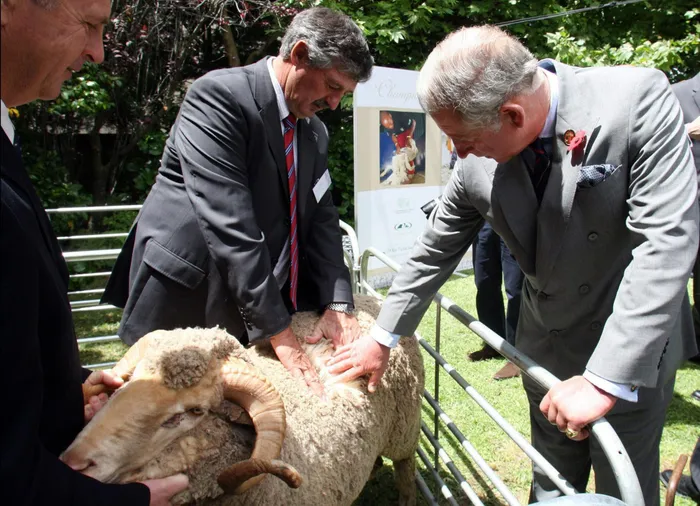Open wool export markets in China with political dialogue

Britain's Prince Charles touches a sheep during a wool industry gathering at the Mount Nelson in Cape Town, South Africa, Saturday, Nov. 5, 2011. Picture, SHELLEY CHRISTIANS, POOL.
The wool industry’s inability to sell to China for nearly four months now showed South Africa's agricultural sector is facing increasing pressure from stringent trade practices in major export markets, said Agricultural Business Chamber (Agbiz) chief economist Wandile Sihlobo.
China restricted imports from the local wool industry following the outbreak of foot-and-mouth disease, which continues to be a significant challenge for the sector.
Sihlobo said this was a major worry because China is South Africa’s primary wool export market, accounting for about 70 percent of exports, in value terms.
He said other South African wool industry markets are the Czech Republic, Italy, India, Bulgaria, Germany, the US, Malaysia, Japan and Mexico, but these were relatively small and could not offset the losses resulting from China’s restrictions.
“South Africa needs to forge unique relations with China on the wool trade, so we can have mechanisms to insulate the industry at such crucial times,” he said.
This is not the first time South Africa has experienced such a challenge with China. During the 2019 foot-and-mouth disease outbreak, China followed similar harsh practices and temporarily suspended South Africa’s wool imports.
This saw South Africa’s wool exports fall 24 percent year-on-year in 2019 to $302 million (R5.1 billion). The decline was in exports to China, which fell by nearly a third from 2018 in both volume and value terms, he said.
“The wool industry is under pressure, the new entrant black farmers – with less of a financial cushion – feel the impact severely. Black farmers have a strong presence in this industry, with the National Agricultural Marketing Council estimating that black farmers account for 18 percent, 13 percent and 34 percent of wool, mohair, and cattle production, respectively.”
Sihlobo said the present-day ban arrived at an economically challenging time, as input prices for all agricultural industries were rising.
For the livestock sub-sector or wool industry, animal feed prices and all logistics costs were adding cost pressures on farmers.
“There are also household financial pressures for small and medium-scale farmers who rely on the proceeds of this industry to sustain families. Without access to the Chinese market, the wool industry will likely be under strain for some time. At a national level, this will also show in the export earnings.”
Wool was the eighth most significant agricultural exportable product in 2021, accounting for 3 percent or $326m in South Africa’s exports of $12.4bn.
Importantly, in the first quarter of this year, the export activities were still smooth.
The glitches started at the beginning of the year’s second quarter, with the foot-and-mouth disease outbreak on a few cattle farms. The episode overlapped with China’s closing of some of its trading hubs with tough lockdowns to curb the spread of Covid-19.
“Still, China has reopened its economy, and South Africa’s wool industry is still strained,” he said.
Last week Roelie van Reenen, supply chain executive at beef product supplier Beefmaster Group, said if the foot and mouth disease was not brought under control, the ramifications for the industry would be dire.
“The threat that it poses to the cattle industry is tremendous. All industry role-players need to take seriously their responsibility to help limit the spread of the disease as much as possible, as we cannot expect government authorities alone to clamp down on it. We simply have to stop it from spreading further,” Van Reenen said.
given.majola@inl.co.za
BUSINESS REPORT